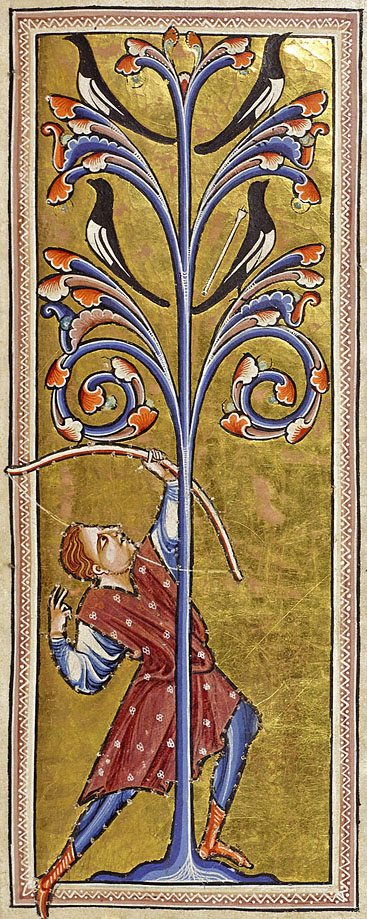The Aberdeen Bestiary (Aberdeen University Library MS 24) is considered to be one of the best examples of its type due to its lavish and costly illuminations. The manuscript, written and illuminated in England around 1200, is of added interest since it contains notes, sketches and other evidence of the way it was designed and executed. Its text and appearance are closely related to the Ashmole Bestiary, Oxford, Bodleian Library, MS Ashmole 1511 which provides further insights into workshop practice.
Original Website Project
In 1996 Aberdeen University created a website for the manuscript. For this, the book was photographed using slides which were subsequently scanned. The text was transcribed and translated, supported by a commentary and introduction. The original team consisted of:
- Michael Arnott, web designer
- Iain Beavan, project manager
- Michael Craig, photographer
- Jane Geddes, commentary
- Morton Gauld and Colin McLaren, both consultants for the transcription and translation
- Jane Pirie, project assistant
New Photography and Website
The Aberdeen Bestiary was photographed for the first time in the mid-1990s using an SLR camera, and the resulting images were incorporated into the original project website. The website and the images have remained popular, indeed the images are amongst the most requested in our collections. However, digital imaging has improved dramatically over the intervening years and it is now possible to capture tremendous amounts of detail, in some cases, a level of detail not clearly visible to the naked eye.
Special Collections uses a Canon EOS DSLR camera which produces excellent images, but in order to capture the highest level of detail possible, we elected to make use of the services offered by The University of Manchester Library’s Centre for Heritage Imaging and Collection Care (CHICC) which specialises in high-resolution imaging. Given the importance and value of The Aberdeen Bestiary, and the risks associated with taking it out of a controlled environment, we elected to have the photography done in the Glucksman Conservation Centre in The Sir Duncan Rice Library.
In early 2015, in preparation for the visit, Glucksman Conservation Centre staff carried out a page by page condition check of the Bestiary to both record the current condition of each page and assess the stability of the structure, support and media to ensure that the volume could undergo digitisation safely. Each page was also analysed for any details or faint sketches that would benefit from new photography, indeed several previously undetectable sketches were identified with the aid of a light sheet.
At the end of March 2015, CHICC’s photographer, Jamie Robinson, arrived in Aberdeen. He brought their mobile unit, the Manfred Mayer Travellers Conservation Cradle, which has built in ultraviolet filtered LED lights. The LED lights are 'cold' and are used for this purpose because they emit as little heat as possible and the unit is fully adjustable to allow careful handling of fragile books and manuscripts. The camera CHICC used for the photography is a Phase One medium format digital camera with an IQ180 Digital back. The image quality from the IQ180 is unparalleled, giving a full output of 80 million pixels, each RAW image alone is around 70mb.
Over the course of two days, 345 images were captured. All the pages were photographed in full and then using raking light, other details such as pricking marks, illustrations, sketches and paint fragments were photographed in great detail. The small illustration of the sun of folio 41r was barely discernible before, but the new photography reveals it almost in full. The illustration of the dove on folio 27v now clearly shows that silver was used to colour it where previously it just appeared flat. Even the depth of the holes created by pricking marks around many of the illustrations is now evident.
As with digital imaging, website has also developed to such an extent that we now have high definition zoomable views of the pages which reveal the incredible detail captured by the camera and allows the user to examine conservation issues. The new website combines all elements from the original website such as commentary, translation and transcription onto a single page view with a zoomable image and the opportunity to view page openings side by side. It is also is optimised to adapt to devices such as mobile phones and features a full thumbnail index and new search. The transcription and translation remain the same but the commentary has been updated where necessary.
The new photography and website is a result of the combined skills of many people across a range of disciplines. The University of Aberdeen team consists of:
- Louisa Coles, Paper Conservator
- Siobhan Convery, Head of Special Collections - Project Sponsor
- Kim Downie, Digitisation Officer
- Professor Jane Geddes, Chair in History of Art - Editor, Commentary (with additional editorial commentary by Professor Richard Gameson of Durham University)
- Julie Smart, Technology Support Officer - Project Manager and Application Developer
- Zeno Zaplaic, Web Developer - Application Developer
The photography was carried out by Jamie Robinson from The Centre for Heritage Imaging and Collection Care (CHICC) at The John Rylands Library, University of Manchester.
In addition, a team from Durham University led by Professors Andrew Beeby and Richard Gameson made a study of the pigments for their national project on manuscript pigments using Raman spectroscopy.

